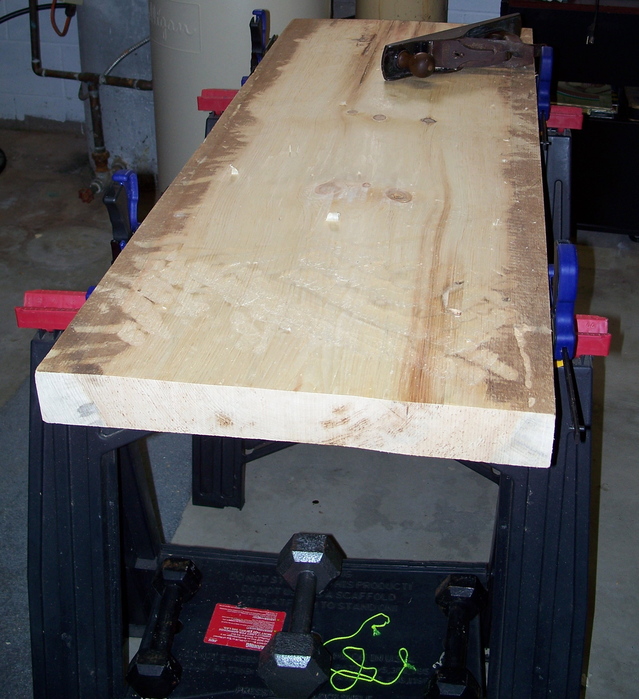I put away the Scrub. It was time to pick up the Jack.


When I did, I learned a few things.
I knew that using a single slab of wood for a bench-top was a bad idea. All the books talk about wood movement (humidity & temperature induced expansion & contraction) being magnified by using a single slab. But the slab was there, and only $35, and I thought "how difficult can it be?" What I didn't know was how a slab anything is a knotty problem. Look carefully at the picture. There are 6 knots in the slab, in 2 groups. The groups are roughly equidistant from the center. If you look really carefully (open the image) you'll see tear-out around the knots. The knot, itself, is endgrain. The wood around it is surfacegrain, but changes direction around the knots. Planing with the grain is not easy, when the direction of the grain changes within the length of the plane. Oh -- and the center of one knot is dessicated. So, rather than shearing cleanly when I plane it, it comes out in dry chunks. Leaving a good-sized hole in the surface.
At the far end of the slab (as seen in the image) is a very nice area of burl wood. It's really pretty. It's gorgeous, rippling, wavy, . . . I swear I can see flecks in it, like in Oak. And different colors. But it's all too easy to tear, because burl doesn't so much have grain as an EKG reading.
And I haven't mentioned the insect holes or the dessicated split near the burl, or the not-quite-burl at the near end, . . .
If you look at the near end, you'll see what's left of the gouges left by the Scrub. I don't know, I may have gone too deep, there. Did I mention that this thing is 52 inches long? I can't work the length in a single pass, it's too long for my arms. That means I must worry about creating 2 or 3 flat regions that are different thicknesses.
I haven't had this much fun since I taught myself VBA! I have no idea what I'm doing. I don't think I'm ruining anything. (I can't really -- pine is way too soft to use as a bench; this bench-top's life expectancy is a few years, at best.) Every time I lay down my tools, I can see it's flatter. I see the shavings curl out of the plane, hear the wood being sliced and the plane's sole slide, smell the fresh cut-wood scent, feel the almost-crisp flattened surface and the fatigue in my arms and chest . . . and think about how I can do this, am doing this. Me -- the guy who would have flunked woodshop if they'd let me.
I knew that using a single slab of wood for a bench-top was a bad idea. All the books talk about wood movement (humidity & temperature induced expansion & contraction) being magnified by using a single slab. But the slab was there, and only $35, and I thought "how difficult can it be?" What I didn't know was how a slab anything is a knotty problem. Look carefully at the picture. There are 6 knots in the slab, in 2 groups. The groups are roughly equidistant from the center. If you look really carefully (open the image) you'll see tear-out around the knots. The knot, itself, is endgrain. The wood around it is surfacegrain, but changes direction around the knots. Planing with the grain is not easy, when the direction of the grain changes within the length of the plane. Oh -- and the center of one knot is dessicated. So, rather than shearing cleanly when I plane it, it comes out in dry chunks. Leaving a good-sized hole in the surface.
At the far end of the slab (as seen in the image) is a very nice area of burl wood. It's really pretty. It's gorgeous, rippling, wavy, . . . I swear I can see flecks in it, like in Oak. And different colors. But it's all too easy to tear, because burl doesn't so much have grain as an EKG reading.
And I haven't mentioned the insect holes or the dessicated split near the burl, or the not-quite-burl at the near end, . . .
If you look at the near end, you'll see what's left of the gouges left by the Scrub. I don't know, I may have gone too deep, there. Did I mention that this thing is 52 inches long? I can't work the length in a single pass, it's too long for my arms. That means I must worry about creating 2 or 3 flat regions that are different thicknesses.
I haven't had this much fun since I taught myself VBA! I have no idea what I'm doing. I don't think I'm ruining anything. (I can't really -- pine is way too soft to use as a bench; this bench-top's life expectancy is a few years, at best.) Every time I lay down my tools, I can see it's flatter. I see the shavings curl out of the plane, hear the wood being sliced and the plane's sole slide, smell the fresh cut-wood scent, feel the almost-crisp flattened surface and the fatigue in my arms and chest . . . and think about how I can do this, am doing this. Me -- the guy who would have flunked woodshop if they'd let me.

